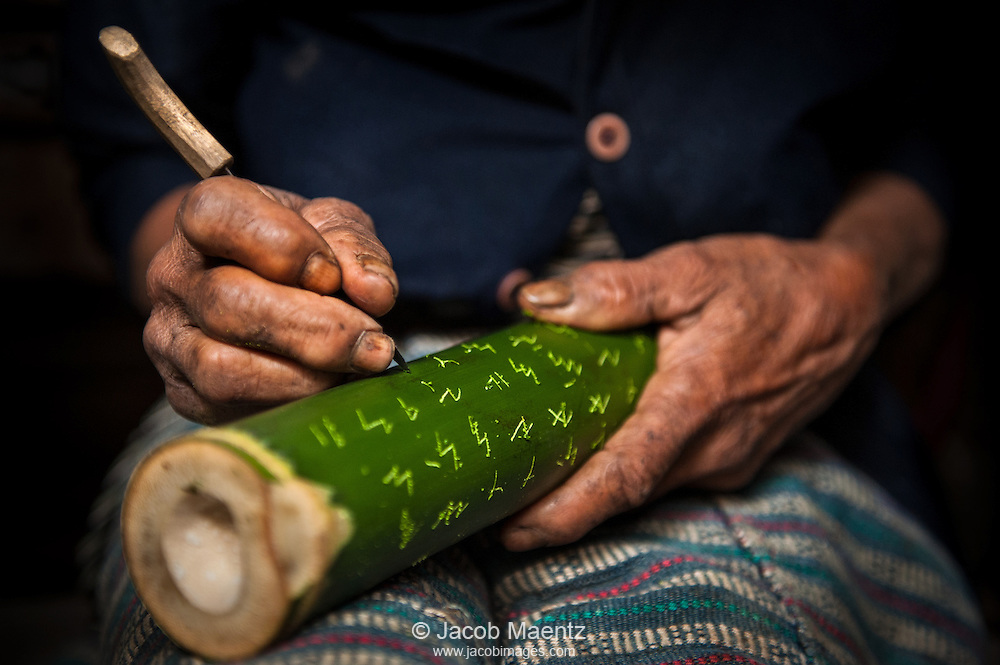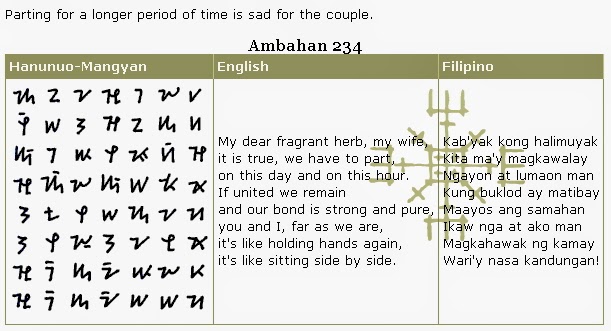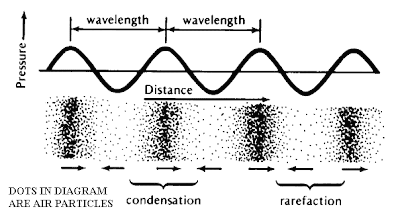The Ambahan is a literary product and poetic expression of the Southern Mangyans of Mindoro, Philippines. Although there are about seven different ethnic groups living in Mindoro, collectively called the Mangyans, these groups are quite distinct from each other as to language, customs, and way of living. Only the ethnic group living in the south of Mindoro, roughly comprising the areas within the municipalities of Bulalacao (San Pedro), Mansalay, Oriental Mindoro and San Jose, Occidental Mindoro, claims the name Mangyan as the descriptive title of their tribe. To stress their point, they might add the epiteth: "Hanunuo" Mangyan, that is, a "truly, real, genuine" Manygan.
Together with their northern neighbors, the Buhids, they possess a pre-Spanish writing system, considered to be of Indic origin, with characters expressing the open syllables of the language. Two distinct syllabaries are still in practical use among the ethnic groups in Mindoro, viz. the northern Buhid on one hand and the southern Buhid with the Hanunuo-Mangyans on the other. The existence of a writing system among these tribes certainly accounts largely for the wealth of literature prevalent among them. One of the literary products, the one written down most frequently on bamboo-tubes or slats, is the ambahan.
For better understanding and appreciation of the ambahans presented here, a short outline on the character and use of the ambahan will be given here.
As a definition, it can be stated that the ambahan is:
- A rhythmic poetic expression with a meter of seven syllable lines and having rhythmic end-syllables.
- It is most often presented as a chant without a determined musical pitch or accompaniment by musical instruments.
- Its purpose is to express in an allegorical way, liberally using poetic language, certain situations or certain characteristics referred to by the one reciting the poem.
In an effort to conform to the rule of having only seven syllables in each line, the composer tries to fit his words within the pre-determined quantity of syllables. This accounts for the many elisions and contactions of words that make the reading of the ambahan in the Hanunuo-Mangyan script so difficult and exasperating to the translator. Thus nirwasan comes from niruwasan; nilkasan from nilukasan; the mono-syllables gin from ginan; u from una. Conversely, the words may be extended, i.e. syllables may be added in order to have the required seven syllables. In most cases, the normal procedure involves the use of affixes and suffixes, both of which are extensively used in the Philippine languages. The most common one in the Hanunuo-Mangyan language is the suffix -an. Manok becomes manukan, balunos becomes balunusan, without a change in meaning. Within the word, "extensions" may also be found which might be old infixes, no longer common. So dayap becomes dalayap, layaw becomes lugayaw. Another way of lengthening a word is by repeating the word itself, not so much to make it superlative in meaning (e.g. in Tagalog: laking-laki), but rather to complete the seven syllable requirement.
While it is not my intention to be technical on this point, as a linguist's analysis of morphological phenomena would be, the foregoing illustrations demonstrate that the prescribed scheme of seven syllables in ambahan verse gives ample opportunity for lexical calisthenics, an exercise which may fascinate many students.
The rhyming end-syllables are an essential feature of the ambahan. The most common rhyming syllable is -an, being a regular suffix for verbs and substantives in the Hanunuo-Mangyan language. But other combinations with the vowel a are rather common too, such as in lines having the end-syllables: a, ak, ag, ang, as, aw, ay. Here the vowel a is combined with nearly all the consonants in the Philippine alphabet. In the same way, the vowels I (or e) and o (or u) can be found as the rhyming syllables, either alone or in combination, e.g.: I, id, ing, ip, it, and o, od, ok, on, ong, os, ot, oy.
Ambahan and its uses
Ambahans are known and recited by Hanunuo-Mangyans, both old and young. Of course, different ambahans will be appropriate for different age groups.
The children definitely have their own kind of Ambahans, something which might be considered as the equivalent of our nursery rhymes. However, even in these rhymes all the elements of the ambahan are present; the main distinction lies in the simplicity of the language used. The ambahans for children, however, are short, most of them containing not more than six lines.
A boy (kan-akan) and a girl (daraga) would be familiar with the ambahans fit for them, but once they are married, they would acquaint themselves with the ones that are appropriate for their new state of life.
Like all poetry, the Ambahan is an expression of an idea or feeling in a beautiful and harmonious language. Unlike other forms of poetry , however, the Ambahan is not poetry for its own sake or for the poet's satisfaction. The Ambahan is primarily a poem of social character; it finds its true existence in society. It is created by the Mangyans to serve practical purposes within the community. It is used by the parents in educating their children, by young people in courting each other, by a visitor in asking for food and by a relative bidding goodbye or farewell. Of course, it would be a mistake to think that the Mangyans converse with each other only by the ambahan. If a man comes from his field, he would not use an ambahan to tell his wife that he is hungry; he will express the feeling of his stomach in plain and clear language. But generally speaking, the ambahan is used on those occasions when something embarrassing, unpleasant, delicate or even precious (as love) has to be said. For instance, a boy may tell a girl in plain language that he will never forget her, but it would sound so much nicer if he were to do so in an ambahan.
The social nature of the ambahan has given rise to a kind of verbal contest. Whenever Mangyans are together, a few of them (often the older generation) will eagerly compete with each other in the ability to recite the ambahan called for by the place and the occasion. Among these occasions are festivities held in connection with reburial. One Mangyan might challenge another with an ambahan, for example. This starts the contest. The people gather around the two contestants (without agreement, without rules, without bets), listening intently to the ambahans recited alternately by the two opponents. Each ambahan recited is an answer to the problem or theme propounded in the ambahan preceeding it. Both contestants are lustily cheered and encouraged by their supporters. In most cases, the one who recites last is declared the winner. The contest may go deep into the night. Whether one or the other wins is unimportant; what matters most is the entertainment derived from the contest.
A few final remarks about the translation of the ambahan may still be of interest. A researcher who happens to be in the mountains of Mansalay and becomes acquainted with the ambahan will become enthusiastic about it and may even want to translate some of them into his own language. But before he can translate the ambahan, he must study the ancient Indic script. After having mastered it well, he will find out to his dismay, that he still cannot read everything written on the bamboo. This is due to the fact that the script itself does not show the final consonant of each syllable. When he has overcome the disappointment, he will probably try to get an ambahan written down in clear, readable letters. Tape-recording the ambahan would take away the initial difficulties of copying from script. However, even then he will not understand all the implications of the ambahan unless the Mangyan can explain it.
In translating an ambahan, we find a special difficulty arising from the symbolic meaning of the words used. The Mangyan may supply the applied allegorical meaning but he might not understand the literal meanings of certain words. The meanings of these words can often be discovered because of the frequent use of repetition of ideas. Sometimes complete lines may be repetitions of the same idea in synonymous words.
Ambahan: Birth and infancy
Ambahan no.3
My dear baby, do not cry
'cause the wild cat might hear us!
The big one from over there,
with his awful long-stretched howl!
Helpless are we if he comes.
Our spear is broken still and
our bolo bent and blunt!
'cause the wild cat might hear us!
The big one from over there,
with his awful long-stretched howl!
Helpless are we if he comes.
Our spear is broken still and
our bolo bent and blunt!
Huwag ka ngang umiyak
Hala ka at mapukaw
Pusang-ligaw sa gubat
Ngumiyaw, maghihiyaw
Wala kitang pambugaw
Sibat nati'y nawasak
Gulok nati'y nabingaw!
Ambahan no.4
Don't be noisy, baby dear!
The wild iro might come here.
The one out of the deep woods.
How to fight him when he comes?
Broken is our spear in two
and our bolo disappeared!
H'wag ka ngang magulo
May laog nanunubok
Mula gubat susugod
Wala kitang panghamok
Sibat nati'y napulpol
Itak ay anong purol!
Ambahan no. 5
You, my baby, don't make noise!
Some strange animal might come,
coming from across the streams.
Knocking on the house, he will,
with his glittering sharp claws,
No weapons for us to kill;
our bolo we cannot use,
rusty is our spear and blunt
Hala ka at mapukaw
Pusang-ligaw sa gubat
Ngumiyaw, maghihiyaw
Wala kitang pambugaw
Sibat nati'y nawasak
Gulok nati'y nabingaw!
Ambahan no.4
Don't be noisy, baby dear!
The wild iro might come here.
The one out of the deep woods.
How to fight him when he comes?
Broken is our spear in two
and our bolo disappeared!
H'wag ka ngang magulo
May laog nanunubok
Mula gubat susugod
Wala kitang panghamok
Sibat nati'y napulpol
Itak ay anong purol!
Ambahan no. 5
Some strange animal might come,
coming from across the streams.
Knocking on the house, he will,
with his glittering sharp claws,
No weapons for us to kill;
our bolo we cannot use,
rusty is our spear and blunt
Anak, 'wag kang ngumalngal
Hala ka, may bakulaw!
Sa dahilig do'n buhat
Tutuktok sa suliras
Kay tulis ng galamay
Wala kitang pamatay
Tong itak walang saysay
Kinalawang 'yang sibat!
Hala ka, may bakulaw!
Sa dahilig do'n buhat
Tutuktok sa suliras
Kay tulis ng galamay
Wala kitang pamatay
Tong itak walang saysay
Kinalawang 'yang sibat!
Ambahan: Courtship
Many pages of sweet-flowing romances have been written about courtship, but the Mangyans create their own by using the examples of the budding and flowering plants and trees around them.
Ambahan: Marriage
Although the courtship period has a varied set of rules and ceremonials, the marriage itself is as simple as possible. After the consent of the parents has been obtained, the unceremonial first sleep of both the spouses together is considered as wedlock itself.
In the ambahan literature, a major part revolves around the perennial theme of married life and all its ramifications. After many years of living together, does the husband still remember his promise that he gave as an ardent lover?
for more information about these topic: visit
https://cnnphilippines.com/life/culture/2018/08/22/ancient-Filipino-scripts-surat-Baybayin.html























